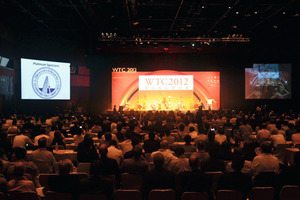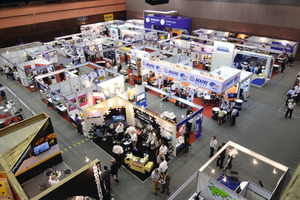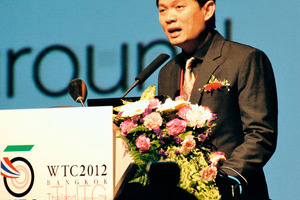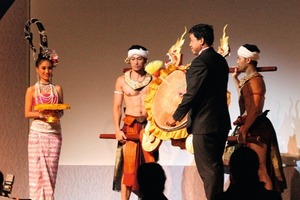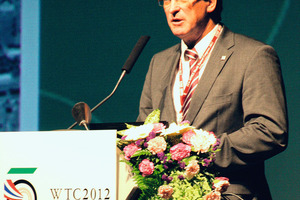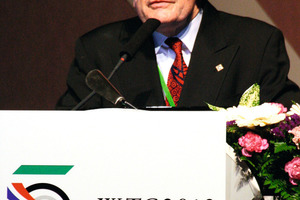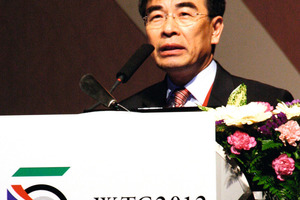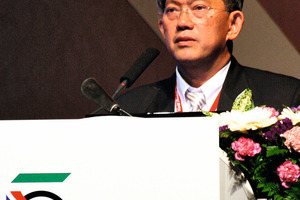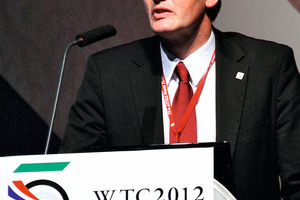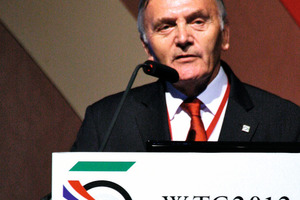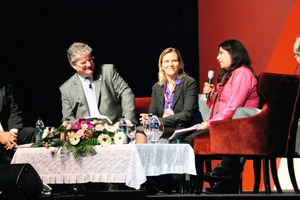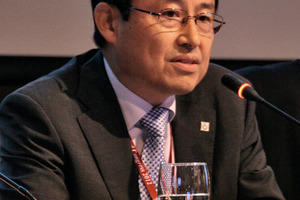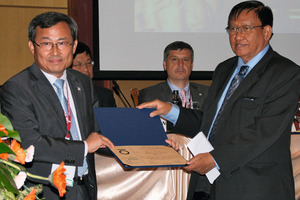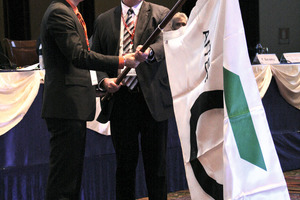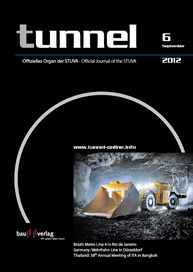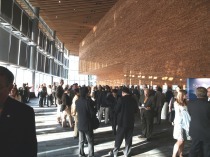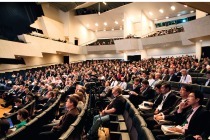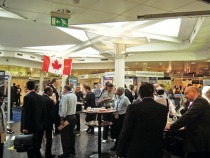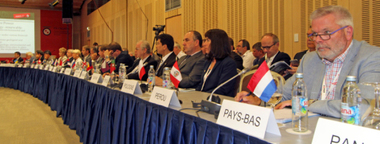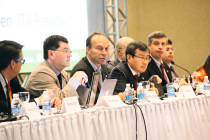38th Annual Meeting of the International Tunnelling and Underground Space Association – World Tunnel Congress 2012 in
Bangkok, Thailand
Every year tunnellers meet in a different member country somewhere in the world for their annual meeting and discuss the latest trends and developments. The following report provides an overview of the contents of the Congress, the results of the Working Groups (WGs) and further interesting news.
1 General
Approx. 1,300 tunnellers from 61 nations met in Bangkok, Thailand from May 18 to 24, 2102. The occasion: the 38th Annual Meeting of the ITA – International Tunnelling and Underground Space Association – in conjunction with the 2012 World Tunnel Congress. The Tunnel Congress staged by the Underground & Tunnelling Group (TUTG) and the Engineering Institute of Thailand under his Majesty the King’s Patronage (EIT) was captioned “Tunnelling and Underground Space for a global Society” (Fig. 1). 53 of the 68 member countries were represented in Helsinki. With a percentage of 78 % the number of countries represented was thus similar to that of the previous year (roughly 77 %).
The following countries were represented:
Argentina, Australia, Austria, Azerbaijan, Australia, Belarus, Belgium, Bosnia and Herzegovina, Brazil, Bulgaria, Canada, Chile, China, Colombia, Costa Rica, Croatia, Czech Republic, Denmark, Ecuador, Finland, France, Germany, Greece, Hungary, India, Iran, Italy, Japan, Republic of Korea, Macedonia (FYROM), Malaysia, Mexico, Montenegro, Myanmar, Nepal, Norway, The Netherlands, Poland, Portugal, Romania, United Kingdom, Russia, Serbia, Singapore, Slovakia, Slovenia, South Africa, Spain, Sweden, Switzerland, Thailand, Ukraine, United Arab Emirates and USA.
The following ITA member countries were not represented in Bangkok:
Algeria, Egypt, Iceland, Israel, Indonesia, Kazakhstan, Laos, Lesotho, Morocco, Panama, Peru, Saudi-Arabia, Turkey, Venezuela and Vietnam.
2 World Tunnel Congress 2012
The Congress was prepared and organised mainly by the Thai Tunnelling Group in collaboration with the ITA. The conference programme embraced 14 main themes, which were presented at 32 technical sessions:
1. Urban Tunnelling
2. Use of Underground Space
3. Advance and Innovation in mechanised Tunnelling
4. Conventional Tunnelling
5. Long and deep Tunnels
6. Contract Practices, commercial Aspects and Risk Assessment
7. Tunnelling nearby sensitive Structures
8. Conventional Tunnelling, Tunnel Rehabilitation and Restoration
9. Safety in Tunnels
10. Micro-Tunnelling
11. Deep Excavation
12. Natural Disaster Mitigation and Management through Underground Space Use
13. Underground Structure Resistance against seismic Loads
14. Southeast Asia Session
The contributions for the conference programme were augmented by various poster presentations and an accompanying exhibition involving 89 companies (Fig. 2).
As in previous years a special ITA training course was held prior to the Congress itself on May 18 and 19. On this occasion it was jointly organised by the Thailand Underground and Space Group (TUTG), the ITA and the ITACET Foundation. The course for young professionals was captioned “Urban Tunnelling in Urban Areas”. Altogether 163 participants from 33 different nations attended. Participants from threshold countries were granted a special discount in order to propagate knowledge on underground construction more effectively there. The Foundation also invited 5 guests from the new ITA member country Myanmar to attend free of charge for the same reason.
The 19 papers presented by internationally recognised experts from the academic and entrepreneurial fields were delivered with the intention of explaining current possibilities for producing tunnels under the conditions prevailing in urban areas. On Day 1 the participants were first shown the significance of underground facilities as well as their planning principles. Subsequently the focus turned to topics such as conception, general construction methods, segmental linings and shotcrete. The first part of Day 2 was devoted to selected aspects: restricting damage, risk management, face stability, geological investigations and monitoring. During the second part of the day industrial representatives dealt with the latest developments from various fields.
The lively ensuing discussion reflected the great interest shown by those taking part in the topics and the successful conclusion of the course. The ITACET Foundation and the Swiss Tunnel Society are already engaged in laying the groundwork for the next training course, which will supply information on grouting, freezing methods, jetting, drainage, pipe umbrellas/ spiles and face anchoring under the heading “Ground Improvement, Pre-Support and Reinforcement Methods”.
During the opening ceremony on the Monday, words of welcome were forthcoming from Suchatvee Vince Suwansawat (chairman of the organising committee, Fig. 3) and In-Mo Lee (ITA president). The participants were then also welcomed by a video message from UN Secretary-General Ban Ki Moon. Subsequently the conference was opened by the Deputy Minister of Transport, Associate Professor Dr. Chatchart Sithipan (Fig. 4).
The third lecture in memory of Sir Alan Muir Wood was then presented at this year’s WTC. In the “Muir-Wood Lecture”, Professor Fritz Grübl, Hochschule der Technik Stuttgart (Fig. 5), examined “Segmental Ring Design – New Challenges with high Tunnel Diameters”. Taking the example of the planned Orlovski Tunnel in St. Petersburg with a ring external diameter of 18.65 m, Grübl indicated which aspects required the most attention when dimensioning such large cross-sections. In this connection he dealt with determining the earth pressure, establishing the forces from driving and ring production as well as the longitudinal and lateral joint geometry. He explained in detail which special aspects have to be taken into consideration for static calculation and the particular characteristics possessed by reinforced concrete segments.
Three top keynote papers were then presented:
1. Geotechnical Design & Tunnel Engineering: Roots of Eastern & Western Engineering Cultures (Dr. Harald Wagner, Austria)
2. Use of underground Space in Seoul and its foreseeable Future (Prof. Seung Ryull Kim, Korea)
3. Underground Space Engineering for Infrastructure Development in Thailand (Dr. Noppadol Phienwej, Thailand)
Wagner (Fig. 6) used his presentation to put forward ideas with regard to how the quickly growing markets of Southeast Asia can be provided with suitable underground infrastructures. Towards this end, on the one hand the established (western) technologies are to be applied albeit in conjunction with the eastern view of a planet earth functioning in geotechnical terms. Wagner believes that in this way all kinds of infrastructures such as those for transport, water, energy and communications can be harmonised with eastern philosophy that has existed for thousands of years in perfect accordance with the choreography of the universe.
Kim (Fig. 7) offered a holistic view of the use of the underground space in the megacity of Seoul in his contribution. In the last 40 years in particular, Seoul has developed into one of the world’s most densely populated cities. As a result, substantial investments have been poured into an underground infrastructure to provide people with a proper life environment. He also touched on a number of planned projects, which will possibly be undertaken in the near future.
Phienwej (Fig. 8) first presented a short overview of underground construction activities in Thailand concentrating on Bangkok. He focused especially on what is the city’s till now sole Metro line (blue line), which was produced a number of years ago in the densely populated urban area. He then went on to deal with the (major) tunnel construction measures planned in Thailand. In this respect he honed in on extending the Bangkok Metro, a water diversion tunnel in the north of Thailand as well as renovating the flood water collection system in the greater Bangkok area.
At the beginning of the ITA Open Session on the Tuesday, 4 Working Groups presented their results to a larger audience. At the session chaired by ITA vice-president Professor Markus Thewes (Fig. 9) first of all, Eric Leca and Chung-Sik Yoo, animateur and vice-animateur of WG 2 “Research” provided details of its ITA Report on “Monitoring and Control in Tunnel Construction”.
Subsequently Donald Lamont, who heads WG 5 “Health and Safety in Tunnelling” examined 2 published ITA Reports: one on “Guidance on the Safe Use of temporary Ventilation Ducting in Tunnelling” and the other on “Guidelines for good Working Practice in high Pressure compressed Air”.
Then Christian Ingerslev, the animateur of WG 11 “Immersed and Floating Tunnels”, presented his group’s report “An Owners Guide to Immersed Tunnels”. To wind things up, Wout Broere, in charge of WG 20 “Underground Problems – Underground Solutions” discussed the group’s “Report on Underground Solutions for Underground Problems”. As representative of the World Road Association (PIARC), Pierre Schmitz, then dealt with the latest developments between the PIARC and ITA. He particularly referred to the PIARC Road Tunnel Manual, which is available free of charge on the PIARC websites in English and French (tunnels.piarc.org).
The remaining part of this year’s Open Session was devoted to “Planning better and resilient Cities”. The session was a feature of the so-called “ITA Global Perspective”, which bore the title “Urban Underground Space in a Changing World”.
In the course of 3 years, the ITA will illuminate how underground spaces can contribute towards solving 2 urgent problems worldwide: the first of these is “Urbanisation” as pursued by the United Nations Human Settlements Programme (UN-HABITAT) and secondly “Making Cities resilient against natural Disasters and Effects of Climate Change”, which was passed by the United Nations International Strategy for Disaster Reduction, UN-ISDR. Towards this end, one of the first objectives is to produce a document together with 3 global partner organisations constituting urban planners, city administrations and engineers (ISOCARP – International Society of City and Regional Planners, ICLEI – International Council for Local Environmental Initiatives and IFME – International Federation for Municipal Engineering) for political decision-makers underlining the advantages of underground facilities.
Last year in Helsinki, the ITA had devoted an Open Session to a part-aspect, namely “Delivering better and resilient Cities”. Next year in Geneva the topic of the “ITA Global Perspective” in 2013 will be “Deciding better and resilient Cities”. All told the “ITA Global Perspective” consists of 7 activities:
1. Organising the 3 previously mentioned sessions through ITA-CUS (starting with the WTC in 2011); each of the sessions will be accompanied actively by one of the abovementioned organisations (2011 in Helsinki: IFME; 2012 in Bangkok: ISOCARP; 2013 in Geneva: ICLEI)
2. Active inclusion of Working Groups and member countries
3. Continuous cooperation with global partners (based on a corresponding agreement (MoU) as well as extended distribution of knowledge via congresses and workshops)
4. Producing a document for political decision-makers, which lays out the advantages of underground facilities; this paper is to be presented to UN-HABITAT and UN-ISDR
5. Providing grants to students (in conjunction with ITACET) in order to arrive at further results, as to how underground spaces can contribute to the abovementioned global topics
6. Further development of the ITA Global Perspective to become an initiative, which can rely on the involvement of internationally active companies.
7. Summit meetings should be held with urban decision-makers at yearly or half-yearly intervals in order to promote the “ITA Global Perspective” even further and to establish it as part of the commitment with the 2 UN organisations.
Within the ITA, the relevant work is coordinated and undertaken by the Committee on Underground Space (ITACUS). When it was set up, the Committee committed itself to increasing public awareness of the possibilities afforded by underground spaces and facilities.
Consequently the Open Session within the scope of the WTC ’12 was opened and presented by Han Admiraal, chairman of ITACUS. After the presentation of tasks in hand and future challenges by Martin Knights, ITA past-president (Fig. 10), an initial block was devoted to “How do Cities plan for the Use of underground Space?” An insight was provided by Jean-Pierre Palisse of the Greater Paris Region Institute for Urban Planning (IAU-IdF) with “The underground Contribution to Paris Region sustainable Development”. Then the new ITACUS secretary-general Antonia Cornaro examined the planning principles and how relocating traffic underground can improve the quality of life for people. The block was rounded off by a podium discussion chaired by Admiraal featuring Knights, Palisse, Cornaro and Shipra Narang Suri, vice-president of ISOCARP.
In the second block of the session the topic of “How can underground Space contribute to City Resilience?” was examined in a presentation by Chawalit Chantararat, managing director of TEAM Group, Thailand on “The 2011 Thailand Floods”. This was also followed by a podium discussion, which featured Ray Sterling, the deputy chairman of ITACUS and president of ACUUS (Associated Research Centres for the Urban Underground Space), Ilkka Vähäaho, member of the ITACUS steering group, Shipra Narang Suri and Zaw Zaw Aye, vice-president of TUTG in addition to Chantararat.
The third and final block of the forenoon looked at the industry’s role in “How can the global Perspective Programme help our Industry?” First of all, Mark Vollmer, BASF Construction Chemical Asia Pacific presented “The Chemical Industry’s responsible Care Programme”. A final round of discussions featuring top-notch representatives from industry (Daniel Ruckstuhl, chairman of ITATECH, Dr. Martin Herrenknecht, Herrenknecht, Pekka Nieminen, Sandvik, Felix Amberg, Amberg Group and Enrico dal Negro, MAPEI) brought proceedings to a close.
3 General Assembly
President In-Mo Lee, Korea, (Fig. 12) chaired the General Assembly. Firstly Lee informed the delegates about the development of membership. Since the previous year the number of member countries has risen by 4 to 68. Costa Rica, Ecuador, Macedonia (FYROM) and Myanmar have joined the ranks (Fig. 13). In addition there are 12 new corporative and 3 new individual members. Making allowance for those who have bowed out, the ITA now has 68 member nations, 190 corporative and 115 individual members. Three companies have just declared their willingness to further the aims of the ITA as “prime sponsors” and 6 as “supporters”. This means that the ITA now has 15 prime sponsors and 23 supporters.
Changes to the ITA statutes and rules of procedure were discussed at the previous General Assembly in Helsinki. The final draft was made available to the member countries prior to the session for their perusal so that it could be passed. The position of the secretary-general has been revised in the ITA’s organisational structure in the now valid version. His responsibilities will in future be taken over by the president and his duties fulfilled by the executive director. As far as membership is concerned, clarification ensued regarding the role of the Executive Council members, the various kinds of members (corporative, individual and honorary) as well as prime sponsors and supporters. Furthermore the rules for the different elections were tightened up. This revision process was also applied to standardise various terms and harmonise the English and French versions.
Furthermore the regulations concerning the ITA’s financial participation in the world tunnel congresses were amended in the rules of procedure. As a result, in future, the ITA will not solely be entitled to a share of the participant fees but also to a fixed lump sum and further percentage shares from various receipts.
As in previous years, the members were informed about the means of communication used by the ITA and their development:
The ITA Newsletter “Tribune”, which has only been published on an annual basis since 2005, was provided in printed form for the last time in 2011 at the WTC 2011 in Finland. This year, for the first time the newsletter is only available on the webpage.
Five issues of the “ita@news” have been published since the General Assembly in May in Helsinki (Finland) and sent by e-mail. Thus the latest news from the ITA, its working groups, the member countries, on future conferences relating to tunnelling, exhibitions, workshops and seminars as well as indications about the activities of international sister organisations has been published altogether 44 times. The distribution of “ita@news” now embraces some 8,000 persons, companies, architectural offices and other organisations. The ITA Secretariat is interested in obtaining a feedback from regular readers.
The ITA scientific organ, the journal “Tunnelling and Underground Space Technology (TUST)” is now only accessible to ITA members in electronic form – albeit it contains the entire archives. In 2011 (year 26), 6 issues were published, containing a total of just under 800 pages. In 2012 (year 27), so far a further 5 issues with in excess of 1,000 pages have been brought out.
The ITA Website is visited by around 5,800 users per month from 130 different countries with the average session amounting to over 10 min. In addition to publicly available pages there is also a password-protected area for the internal exchange of data. Additionally there is a newly developed part of the Website, which is intended for decision-makers and the general public. Information on utilisation and planning of underground facilities is provided here as well as their specific advantages.
As in previous years, the report on the activities of the various ITA Working Groups (WGs) occupied a substantial amount of the General Assembly’s time. The pertinent details are provided in Chapter 5.
The General Assembly decided on the venue for the 2015 Annual Meeting. The cities of Dubrovnik (Croatia), Copenhagen (Denmark) and Munich (Germany) applied. Croatia received half (26) of the total votes cast (52) in the first round with Denmark and Germany receiving roughly the same amount each. In the second round of voting, Croatia received the required absolute majority from the delegates (29).
In this connection the dates and venues for future annual meetings are surely of interest:
• May 31 to June 5, 2013, 39th ITA Annual Meeting in Geneva (Switzerland); captioned “Underground – the Way to the Future” (Fig. 14)
• May 9 to 15, 2014, 40th ITA Annual Meeting in Foz do Iguaçu (Brazil); with the topic “Tunnels for better Living”
• May 22 to 28, 2015, 41st ITA Annual Meeting in Dubrovnik (Croatia); captioned: “Promoting Tunnelling in South East European Region”
At the Bangkok General Assembly a video was also shown, which was commissioned to attract new blood to tunnelling and is thus especially devised for young people. The video can be viewed on the ITA webpage ().
4 ITA Executive Council (EC)
All members of the EC were elected for 3 years or confirmed in office as well as nominated for new tasks at the 2010 General Assembly in Vancouver 2 years ago. As a result, no elections took place this year. The ITA Executive Council is thus still made up as follows:
• I.-M. Lee, Korea,
president till 2013
• M. Knights, UK,
past-president till 2013
• M. Thewes, Germany,
1st vice-president till 2013
• B. Yun, China,
vice-president till 2013
• S. Eskesen, Denmark,
vice-president till 2013
• I. Hrdina, Czech Republic,
vice-president till 2013
• A. Elioff, USA (till 2013)
• P. Kocsonya, Hungary
(till 2013)
• R. P. Lovat, Canada (till 2013)
• C. N. Ow, Singapore
(till 2913)
• D. Peila, Italy (till 2013)
• F. Amberg, Switzerland,
treasurer from 2011 – 2013
The General Assembly re-appointed S. Calinescu, Romania, as internal auditor for a further year. Vince Suwansawat, Thailand, joined the board as representative of the host nation Thailand for the 2012 World Tunnel Congress and stepped down accordingly after trhe WTC 2012. Felix Amberg, Switzerland, Tarcisio Celestino, Brazil and Davorin Kolić, Croatia, will advise the EC for the World Tunnel Congresses in 2013, 2014 and 2015. Their tenures will run till 2013, 2014 and 2015 respectively. Since 2009 Olivier Vion as executive director has backed up the EC.
In the interim the following responsibilities have been defined within the EC:
a) Technical Affairs: Thewes, Elioff and Peila
b) General Affairs: Eskesen, Ow and Kocsonya
c) Sponsor and Industry Relations: Hrdina and Lovat
d) Member Nation Development and Coordination: Bai Yun:
- South-East Asia; Ow and H. Wagner (external experts)
- Russia and neighbouring Countries: Lovat and M. Belenkey (external experts)
e) Communication: Knights.
In addition, the following persons will support the EC in special matters:
• Andre Assis and Piergiorgio Grasso: Development of the Associations in South America
• Harvey Parker: Relations with the United Nations
• Eivind Grov: Relations with the Industry and ITA-TECH
• Yann Leblais: Working Group 11 Tutor
• Tom Melbye: representing the Prime Sponsors (elected for 3 years in January 2012)
5 ITA Working Groups
The Working Groups substantially contribute towards the ITA’s positive presentation to the outside world because this is where collaboration among people from different nations unfolds thus enabling an important exchange of views. Twelve of the active ITA WGs met in Bangkok to continue their deliberations. The animateurs of the WGs reported to the General Assembly on May 23, 2012 on the progress reached by their activities and what was actually scheduled for the months lying ahead.
Animateur:
Eric Leca, France;
Vice-animateur:
Chung-Sik Yoo, Korea;
Tutor:
Søren Eskesen, Denmark
12 experts from 9 countries took part in the consultations. The presentation of a document compiled by the WG on “Monitoring and Control for Tunnel Projects” in the Open Session represented a milestone.
The recommendations on a “Strategy for Site Investigations of Underground Works” are being processed jointly with the ISRM. The current draft was scrutinised and revised during the session. Case examples and contractual aspects have still to be added. For the latter, close collaboration with WG 3 is planned. In addition the topics of “Risk Management” and “Steel Fibre Concrete” are currently being tackled. “Sustainability in Tunnelling” has been earmarked as a further topic in future.
Animateur:
Arnold Dix, Australia;
Vice-animateur:
Martin Smith, UK;
Tutor:
Olivier Vion, Switzerland
23 experts from 15 countries took part in the session.
ITA Report No. 6 captioned “Contractual Framework Checklist for Subsurface Construction Contracts” was published last year. In the interim, with the support of students/postgraduates, 3 different specimen contracts have been accordingly analysed: a NEC contract from South Africa, a SIA contract from Switzerland and a FIDIC contract from East Europe.
The WG examined the Working Group 6 recommendation “Guidelines for good Working Practice in high Pressure compressed Air” from the contractual viewpoint and gave it the green light. The WG 19 document on “Contractual Practices in conventional Tunnelling” is currently under review. Furthermore the “Code of Practice for Risk Management of Tunnel Works” (“Code of Practice”for short) from the International Tunnelling Insurance Group (ITIG) was evaluated and is now officially supported by the ITA.
It is planned to work closely together with the other ITA Working Groups in future as well thus enabling them to produce contractually relevant recommendations on their core activities.
Tunnelling
Animateur:
Donald Lamont, UK;
Vice-animateur:
Martin Vogel, Switzerland;
Tutor:
Ivan Hrdina, CzechRepublic
The completed “Guidance on the safe Use of temporary Ventilation Ducting in Tunnels” and “Guidelines for good Working Practice in high Pressure compressed Air” were presented to the open session.
The delegates from 8 countries who attended thus embarked on a new topic, namely “Guidelines for the Provision of Refuge Chambers in Tunnels under Construction”. Furthermore recommendations for safety in shaft construction operations are under review. These will be carried out in close cooperation with the South African tunnelling committee (SANCOT). In addition a guideline governing the amount of asbestos prevalent in tunnelling is being contemplated.
Animateur:
Henry Russell, USA;
Vice-animateur:
René van den Bosch, Netherlands;
Tutor:
Bai Yun, China
Experts from 19 countries participated at the session.
The consultations in the WG honed in on “Structural Fire Protection for Road Tunnels”. This document was at one time in part included in NFPA guidelines and in the meantime requires to be revised and augmented. As a result it was decided to provide an appendix, in which in particular new material, fire suppression systems and risk analyses are dealt with. In addition exemplary presentations by members of the WG relating to water mist fire suppression systems, sealing measures or data management were discussed.
Animateur:
Wenge Qiu, China;
Vice-animateur:
Gary Kramer, Canada;
Tutor:
Daniele Peila, Italy
9 experts from 4 countries took part in this WG’s deliberations.
It was determined last year that new recommendations should be collated on seismic safety of urban underground structures, the safety of shallow tunnels, safety of particularly long tunnels at great depth and the safety of tunnels in active fault zones. An initial draft, which concentrated on the resultant damage, was discussed. Students, who will be awarded a small fee, are mainly to be employed to collect information in the ITA member countries on existing guidelines, norms and regulations and cater for their translation. The WG has requested a sum of 12,000 euros to be made available from ITA headquarters for this purpose.
Animateur:
Christian Ingerslev, USA;
Vice-animateur:
Jonathan Baber, UK;
Tutor:
Yann Leblais, France
22 experts from 10 nations participated. First of all an overview of 6 new projects was provided, which led to a lively discussion on the special production technologies.
It was already reported that the “Owner’s Guide to immersed Tunnels” was presented during the Open Session: apart from the main document, 6 of 40 planned aspects (concrete, cracks, fire protection, joint elements, segments joints and ventilation) have been added in appendix form.
A report on environmental aspects of immersed tunnels is to be produced in future. Furthermore the list of projects is to be updated and the above mentioned guide for owners initially augmented by a further 8 chapters. A sub-group will compile a guide on “Floating Tunnels”. It is also intended to revise the catalogue of immersed and floating tunnels.
Animateur:
Atsumu Ishida, Japan;
Vice-animateur:
Off-Bjorn Kleven, Norway;
Tutor:
Felix Amberg, Switzerland
23 experts from 13 countries participated in this WG’s discussions.
With reference to the debate held last year on certification for nozzle operators, it can be reported that in the interim, EFNARC (European Federation of National Associations representing Producers and Applicators of Specialist Building Products for Concrete) nozzle operator certification has been officially approved by the ITA. Ongoing activities relate to the scheduled ITA Report on fibre reinforced concrete. A draft revised since the last session in Helsinki was discussed, which relates in particular to suitability tests.
Furthermore a paper on the production and durability of concrete was examined, which is to be published as an ITA Report in future. Collaboration with the ITA-TECH Committee relating to the tightness of shotcrete was agreed on. In addition a sub-WG was formed, which will examine the assurance of shotcrete quality.
Animateur:
Lars Babendererde,
Germany;
Vice-animateur:
Brian Fulcher, USA;
Tutor:
Chum Nam Ow, Singapore
The compilation of outstanding projects, which strikingly display the opportunities afforded by mechanised driving, was augmented by further new projects. In addition the compilation of a guide for applying different driving technologies and general tasks in tunnelling was discussed. It is planned to produce guides on “face supporting”, “backfilling” and “monitoring mechanised drives” in future.
Animateur:
Jan Rohde, Norway;
Vice-animateur:
Yoshikazu Ota, Japan;
Tutor:
Amanda Elioff, USA
The deliberations in Bangkok were attended by 6 experts from 7 member countries.
Firstly 3 presentations on environmentally relevant topics in tunnelling were discussed: relating to vibrations, aggregates and tunnelling in urban and sensitive areas. Based on this it was decided to compile a guide containing recommendations on how to proceed when building underground facilities. The treatment of the excavated material, noise and vibrations are to be accorded particular prominence as well as groundwater-related aspects such as settlements or drainage systems. An initial draft is to be compiled during 2012 so that the completed report can be tabled at the next General Assembly in Geneva in 2013.
Animateur:
Gérard Seingre, Switzerland;
Vice-animateur:
Jenny Yan, China;
Tutor:
Rick Lovat, Canada
10 representatives from 9 nations attended the session.
First of all a draft of the report on access tunnels and shafts, which was prepared in advance by the animateur and translated from French into English by the tutor, was debated. Once case examples are added, the report will be published in 2013. Following a presentation and discussion on the Bioceanico-Aconcagua railway project, which runs through Argentine and Chile, it was decided to compile a report on its financing on the basis of a case study, which will also be published in 2013. Furthermore various presentations were provided including planning and producing long rail tunnels in China as well as tunnelling challenges faced in Nepal’s Himalaya region.
Animateur:
Heinz Ehrbar, Switzerland;
Vice-animateur:
Robert Galler, Austria;
Tutor:
Markus Thewes, Germany
A total of 14 participants from 11 countries attended the WG’s consultations. Two papers were presented at the start of the session: one dealing with “Austrian Guidelines on Monitoring in Conventional Tunnelling” and a second on “Mechanisation in Conventional Tunnelling”.
The main task of WG 19 still concentrates on compiling a guide for special contractual issues in conventional tunnelling. The fourth draft was presented at the session and intensively discussed. It is intended to complete this guide by the WTC 2013 in Geneva so that it can be set before the ITA EC.
As a result of discussions held last year it is intended to produce a document on suitable tunnelling methods in conjunction with WG 14. Work on this project is due to commence in the course of 2012. As a follow-up a guide on monitoring in conventional tunnelling will be tackled probably in 2014.
Underground Solutions
Animateur:
Wout Broere, Netherlands;
Vice-animateur:
Vishwajeet Ahuja, India;
Tutor:
Pàl Kocsonya, Hungary
Ten experts from 7 countries were involved.
In the ITA Report “Urban Problems – Underground Solutions” the WG provided an overview of how typical challenges faced by urban planning can be resolved by making use of underground space. The report was already presented at the open session. It has been welcomed by ISOCARP (International Society of City and Regional Planners) and is regarded as extremely important for urban planners.
A further major aspect still continues to be collecting case examples, pointing to the advantages of underground facilities. Towards this end the focus is directed at the influence of underground infrastructure on tangible values as well as the provision of a solid basis for cost-benefit analysis.
6 ITA Committees
Apart from the Working Groups major groups of subjects on underground construction are the responsibility of “Committees”. They also turned the focus on their activities last year.
Animateur:
André Assis, Brazil;
Tutor:
In-Mo Lee, South Korea
The Committee on Education and Training (ITACET), set up in 2008, is geared to the dissemination of knowledge relating to underground construction. This is fulfilled on the one hand by collaboration and exchange among the involved seats of higher learning as well as by holding training courses and producing training and learning material (texts, presentations, videos etc.). Furthermore the committee determines general conditions for master study courses to enable them to be officially sponsored by the ITA.
Animateur:
André Assis, Brazil
The establishment of a “Foundation for Education and Training on Tunnelling and Underground Space Use” (ITACET), decided on by the member countries at the 2009 General Assembly, was implemented on Sept. 25, 2009. The Foundation serves the administrative and financial execution of educational and training measures. Its main objective is to promote education for persons involved in tunnelling especially in threshold countries. It is mainly engaged in financing, organising and sponsoring:
• Specialised training sessions for professional education
• Certificate courses in establishments of higher education
• Certified trainee programmes for professional development
• Creation of international recommendations, guidelines and standards in education and training actions.
So far 16 training courses have been held worldwide catering for more than 2,000 people. More than 10 further courses are scheduled for the coming 12 months. The topics are diversified and include for example conventional and mechanised tunnelling, floating and immersed tunnels, sealing issues, design principles, numerical methods, operational safety, industrial safety and a great deal more.
In keeping with its statutory obligations the Foundation has so far taken over the study fees for 3 students: first of all, for an Indonesian student to study in Turin, for a native of Turkey to study in France and for a Nepalese citizen to study in Switzerland. Apart from this, participants hailing from threshold countries are enabled to take part in training courses at reduced charges.
Animateur:
Didier Lacroix, France;
Tutor:
Felix Amberg, Switzerland
The Committee on Operational Safety of Underground Facilities (ITA-COSUF) currently has 74 corporative members from 23 countries. Roughly 60 % of the members are companies and architectural offices; 40 % public institutions. COSUF is intended as a centre of competence for the worldwide exchange of expert knowledge and information relating to safety in underground facilities.
These 4 Activity Groups form the core of the committee:
• AG 1: Interaction with European and international Activities
• AG 2: Regulation and best Practice
• AG 3: Research and new Findings
• AG 4: European Forum of Road Tunnel Safety Officers.
COSUF stages a public workshop and an internal one each year. The last public workshop prior to the ITA General Assembly was held on May 23, 2011 in conjunction with the WTC in Helsinki. It was captioned: “Designing Underground Safety – How far to go?” In the meantime, this year’s public workshop has been successfully staged in Rome on June 22, 2012. It was entitled: “Safety versus Economic Crisis”: Cost Efficiency of Tunnel Safety Measures”. The presentations have been or will be sent to the participants on CD and can be made available to COSUF members upon request.
The latest internal, non-public workshop for COSUF members was held in Amsterdam on November 14, 2011 and tackled various aspects of the North-South Metro Line in Amsterdam. The next internal workshop will be staged jointly with AETOS (Spanish ITA National Committee) and PIARC (World Road Association) on October 25 and 26, 2012 in Madrid. On this occasion, it is also open to non-COSUF members and bears the title “Safety in complex Underground Facilities”. Furthermore COSUF supports events organised by third parties providing COSUF also profits from such undertakings. Thus a COSUF block was featured at the SOLIT2 Conference in Berlin at the end of June 2012. COSUF will also be present at the “13th World Conference of ACUUS” in Singapore in early November 2012.
The “Prize for Outstanding Work in the COSUF Working Sector” for 2012 was awarded to Dr. Ying Zhen Li of the SP Technical Research Institute of Sweden relating to tunnel fire dynamics.
Animateur:
Han Admiraal, Netherlands;
Tutor:
Martin Knights, UK
The Committee on Underground Space regards its task to be that of encouraging the public to become more aware of the possibilities afforded by underground space and facilities. With this goal in mind ITACUS staged the 2012 WTC Open Session. There have already been lengthy reports concerning this and the objectives of ITACUS. In this connection it should be mentioned that with Jean Paul Godard standing down, Antonia Cornaro is now secretary-general of ITACUS.
Animateur:
Daniel Ruckstuhl,
Switzerland
At the 2011 General Assembly in Helsinki, the representatives of the member nations decided to establish a new committee for “Technologies and Development”, which is currently chaired by Daniel Ruckstuhl (BASF MEYCO). This committee is intended to provide the suppliers and manufacturers represented in the ITA with a platform to improve technologies and industrial developments in a targeted manner. The aim is to promote new and improved construction technologies as well sustainable developments for underground spaces.
In the long term, ITA-TECH is intended as a forum at which topics on underground construction are discussed openly thus allowing conclusions to be turned into practice. Technological developments in particular are to be lent impetus in order to master the challenges set by the tunnelling industry. These challenges include for example the demand to reduce risks, major time pressure during projects, required cost efficiency, extended safety standards as well as the lack of well trained technical staff.
The ITA-TECH has concrete aims:
• Developing ideas and concepts for new and improved technologies for underground construction
• Establishing technical guidelines and recommendations as the basis for future standards
• Early recognition of trends on the market and in the branch
• Coming up with a mutual understanding for new technologies as the basis for rapid transformation into marketable products
• Providing a backdrop for active exchange of technical information on a regular basis between suppliers, contractors and planners
• Formulating arguments from the viewpoint of industry (prime sponsors) for political decision-makers.
Both experts from the various companies as well as the entire branch profit from accomplishing these objectives through improving the acceptance of underground construction.
Three of the 8 planned ITA Activity Groups, whose activities are geared to coordinating the technical processes in underground construction, have been established:
• Inner Lining and Sealing
• Excavation
• Supervision and Monitoring
A further 5 AGs are intended to follow:
• Exploration
• Lining (temporary Support)
• Installation and technical Furnishing for Operation
• Maintenance and Redevelopment
• Design (concerning all 7 previously mentioned Processes)
The Activity Groups are geared to collecting information, compiling reports, evolving concepts, working out guidelines and recommendations, initiating research projects as well as formulating the required training programmes.
7 Publications and Information
Further details of the World Tunnel Congress and the ITA General Assembly 2012 in Bangkok as well as the most important resolutions passed at the General Assembly and the activities of the Working Groups are published on the webpage , in the ita@news (can be subscribed free-of-charge via ) as well as in the Proceedings and the CD issued in conjunction with the World Tunnel Congress. The Proceedings can also be obtained via the webpage . Details on the committees and the ITACET Foundation are also to be found on their webpages (cosuf.ita-aites.org, itacus.ita-aites.org, itacet.ita-aites.org, ).
The Secretariat of the German Committee for Underground Construction Inc. (DAUB), Mathias-Brüggen-Str. 41, D-50827 Cologne () or the Secretariat of the ITA – International Tunnelling and Underground Space Association (c/o EPFL), GC D 1 402 (Bât. GC), Station 18, CH-1015 Lausanne () as well as the secretariats of the national tunnel associations of the various ITA member countries.

